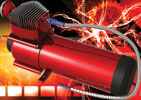

Steam and compressed air are often the most abused and expensive forms of power in a factory. Often compressor housing is designed with undersized piping and air treatment equipment which does not use electricity efficiently.
A pressure drop of 1 bar in an air system is equal to a wasted power cost of R23 777 per annum when a 185 kW air compressor is continuously operated at 28 m³/min (assuming R0,38/kWh). For an energy efficient compressed air system, design engineers might consider the following pointers:
* Before buying a new compressor plant, conduct a professional compressed air audit to determine the plant’s actual air consumption and prevent over or under sizing of the compressor and dryer plant.
* Log air leaks and implement an action plan to reduce them to an acceptable level.
* Select air compressors which satisfy the plant’s volume and quality needs. Variable speed drives may be considered.
* Select an energy efficient air dryer that provides for the dew point needs of the plant with minimal air pressure losses. Over specification will lead to increased long-term running costs. Decentralised air drying, with different types of dryers might be considered to reduce energy wastage.
* If dew points below -40°C are required, consider dew point controllers for dryers with capacities greater than 14 m³/min. Above 21 m³/min, heat regenerative dryers should be mandatory. These have lower purge air requirements and the ensuing power savings are enormous. Recovery time for the extra capital expenditure is often under one year, with continuous payback for the life of the dryer.
* Use power efficient OEM filter cartridges with a pleated construction. These normally have a lower initial Δp and will inflict a lower pressure loss while providing longer service intervals compared to a simple wound cartridge.
* To reduce air wastage when condensates are discharged, use efficient capacitance type intelligent condensate drains for dryers, filters and receivers.
* Design the compressor house with cognisance given to ventilation and efficient re-use of waste heat from the compressors. A 1°C rise in the inlet temperature to the compressor will decrease the compressor’s output capacity by 1%.
* Split the compressor house power supplies to minimise compressed air disruption in the event of a transformer failure.
* Design the compressor house air main piping to achieve an air pipeline speed of 3 m/sec. This will ensure that compressors do not offload prematurely due to pipe line pressure restrictions. It is common to find air compressors running in idle mode, and not able to deliver air to the plant due to undersized and restrictive compressor house piping.
* Design the ring main air distribution system to achieve an air speed of less than 6 m/sec and a maximum 0,2 bar system pressure drop. This will ensure that pipe line losses are minimised.
* Install correctly sloping air lines to ensure good condensate drainage.
* Install the necessary isolation valves to provide efficient management of the compressed air mains in the event of future line changes and maintenance.
* Install an oily waste water condensate management system from the compressor and dryer system. A litre of oil can infect a million litres of water.
* Do not use the diameter of the compressor outlet as a guide for pipeline design. Often compressor manufacturers specify very tight discharge ports.
These are just some of the issues to be considered before a design is finalised. Inadequate design and poor selection of equipment can inflict huge hidden costs on a company and can add hundreds of thousands of rand to the energy bill. It pays to avoid pitfalls at the design stage.
For more information contact Allen Cockfield, Artic Driers, +27 (0)11 425 3484, [email protected], www.articdriers.co.za
| Tel: | +27 11 420 0274 |
| Email: | [email protected] |
| www: | www.articdriers.co.za |
| Articles: | More information and articles about Artic Driers International |
© Technews Publishing (Pty) Ltd | All Rights Reserved